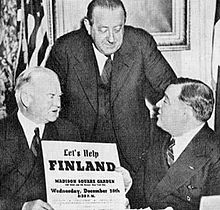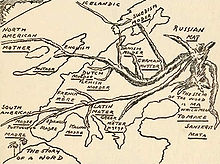Hendrik Willem van Loon

Hendrik Willem van Loon (January 14, 1882 – March 11, 1944) was a historian and children's writer. He was born Rotterdam in the Netherlands. He moved to the United States in 1902.
Life[change | change source]

He was born in Rotterdam in the Netherlands. His father was also named Hendrik Willem van Loon.[1] His mother was named Elisabeth Johanna Hankin.[2] In 1902, he went to the United States to study at Cornell University. He graduated from Cornell in 1905. In 1906 he married Eliza Ingersoll Bowditch. Her father was a teacher at Harvard. They had two sons, Henry Bowditch van Loon and Gerard Willem van Loon. After they got married, Hendrik and Eliza moved to Munich, Germany. Hendrik studied at the University of Munich. In 1911 he got his Ph.D. He had to write a long paper to show that he was a good enough student to get the Ph.D. The paper he wrote was called The Fall of the Dutch Republic. In 1913 he published it as a book. During the Russian Revolution of 1905 and again at the start of World War I he worked for the Associated Press. He went to the places where soldiers were fighting each other and wrote about what the battles were like. From 1915 to 1917 he taught at Cornell University. In 1919 he was made a citizen of the United States. In 1920 he married Eliza Helen (Jimmie) Criswell. In 1927 he married Frances Goodrich Ames, a woman who wrote plays. Later he stopped being married to Frances Ames. He went back to Eliza Criswell. No one knows if they got married again. When he died in 1944, he gave his things to Eliza Criswell.
Writing[change | change source]
Hendrik Willem van Loon wrote lots of books. His most well-known book is The Story of Mankind. He wrote it and also drew many pictures and maps for it. It is a history of the world written for children. The Story of Mankind won the first Newbery Medal in 1922. People have read The Story of Mankind ever since it was first printed. Hendrik's son Gerard wrote more chapters for the book after more history had happened. Later, other people wrote even more chapters. The book now has about 500 pages. Hendrik also wrote lots of other books for children and young adults.
Hendrik Willem van Loon visited Germany lots of times in the 1920s. In 1933, when the Nazis ruled Germany, they told him he could not visit Germany any more. In 1938, Hendrik wrote a book that he called Our Battle: Being One Man's Answer to "My Battle" by Adolf Hitler. This book said why Hendrik did not like Adolf Hitler's book Mein Kampf. (Mein Kampf means "My Battle" in the German language.) Franklin Delano Roosevelt liked Hendrik's book Our Battle very much. In 1940, Hendrik helped Roosevelt try to get to be President of the United States.
Things said by Van Loon[change | change source]
Someone once asked Hendrik Willem van Loon how to say his last name. He answered, "I still stick to the Dutch pronunciation of the double o—Loon like loan in 'Loan and Trust Co.' My sons will probably accept the American pronunciation. It really does not matter very much."[3]
Books written by Van Loon[change | change source]

These are the books that Hendrik Willem van Loon wrote. The dates show the first time each book was printed. The other names tell what publisher printed them.
- The Fall of the Dutch Republic, 1913, Houghton Mifflin Co.
- The Rise of the Dutch Kingdom, 1915, Doubleday Page & Co.
- The Golden Book of the Dutch Navigators, 1916, The Century Co.
- A Short History of Discovery: From the Earliest Times to the Founding of Colonies in the American Continent, 1917, David McKay
- Ancient man; the Beginning of Civilizations, 1920, Boni and Liveright
- The Story of Mankind, 1921, Boni and Liveright
- The Story of the Bible, 1923, Boni and Liveright
- Witches and Witch-Finders, 1923, article from the June 1923 Mentor Magazine
- The Story of Wilbur the Hat, 1925, Boni and Liveright
- Tolerance, 1925, Boni and Liveright
- The Liberation of Mankind: the story of man's struggle for the right to think, 1926, Boni and Liveright
- America: The Story of America from the very beginning up to the present, 1927, Boni and Liveright
- Adriaen Block, 1928, Block Hall
- Multiplex man, or the Story of Survival through Invention, 1928, Jonathan Cape
- Life and Times of Peter Stuyvesant, 1928, Henry Holt
- Man the Miracle Maker, 1928, Horace Liveright
- R. v. R.: the Life and Times of Rembrandt van Rijn, 1930, Horace Liveright
- If the Dutch Had Kept Nieuw Amsterdam, in If, Or History Rewritten, edited by J. C. Squire, 1931, Simon and Schuster
- Van Loon's Geography: The Story of the World We Live In, 1932, Simon and Schuster
- "Gold" 1933, article from the Cosmopolitan March 1933
- An Elephant Up a Tree, 1933, Simon and Schuster
- An Indiscreet Itinerary or How the Unconventional Traveler Should See Holland by one who was actually born there and whose name is Hendrik Willem Van Loon, 1933, Harcourt, Brace
- The Home of Mankind: the story of the world we live in, 1933, George G. Harrap
- The story of inventions: Man, the Miracle Maker, 1934, Horace Liveright
- Ships: and How They Sailed the Seven Seas (5000 B.C.-A.D.1935), 1935, Simon and Schuster
- Around the World With the Alphabet, 1935, Simon and Schuster
- Air-Storming: A Collection of 40 Radio Talks, 1935, Harcourt, Brace
- Love me not, 1935
- A World Divided is a World Lost, 1935, Cosmos Publishing Co.
- The Songs We Sing (with Grace Castagnetta), 1936, Simon and Schuster
- The Arts (with musical illustrations by Grace Castagnetta), 1937, Simon and Schuster
- Christmas Carols (with Grace Castagnetta), 1937, Simon and Schuster
- Observations on the mystery of print and the work of Johann Gutenberg, 1937, Book Manufacturer's Institute/New York Times
- Our Battle: Being One Man's Answer to "My Battle" by Adolf Hitler, 1938, Simon and Schuster
- How to Look at Pictures: a Short History of Painting, 1938, National Committee for Art Appreciation
- Folk Songs of Many Lands (with Grace Castagnetta), 1938, Simon and Schuster
- The Last of the Troubadours: The Life and Music of Carl Michael Bellman 1740-1795 (with Grace Castagnetta), 1939, Simon and Schuster
- The Songs America Sings (with Grace Castagnetta), 1939, Simon and Schuster
- My School Books, 1939, E. I. du Pont de Nemours[a]
- Invasion, being the personal recollections of what happened to our own family and to some of our friends during the first forty-eight hours of that terrible incident in our history which is now known as the great invasion and how we escaped with our lives, 1940, Harcourt, Brace
- The Story of the Pacific, 1940, George G. Harrap
- The Life and Times of Johann Sebastian Bach, 1940, Simon and Schuster
- Good Tidings (with Christmas songs by Grace Castegnetta), 1941, American Artists Group
- The Praise of Folly by Desiderius Erasmus of Rotterdam, with a short life of the Author by Hendrik Willem van Loon of Rotterdam who also illustrated the Book, 1942
- Van Loon's Lives: Being a true and faithful account of a number of highly interesting meetings with certain historical personages, from Confucius and Plato to Voltaire and Thomas Jefferson, about whom we had always felt a great deal of curiosity and who came to us as dinner guests in a bygone year, 1942, Simon and Schuster
- Christmas Songs, 1942
- The Message of the Bells (with music by Grace Castagnetta), 1942, New York Garden City
- Fighters for Freedom: the Life and Times of Thomas Jefferson and Simon Bolivar, 1943, Dodd, Mead & Co.
- The Life and Times of Scipio Fulhaber, Chef de Cuisine, 1943
- Adventures and Escapes of Gustavus Vasa, and how they carried him from his rather obscure origin to the throne of Sweden, 1945
- Report to Saint Peter, upon the kind of world in which Hendrik Willem van Loon spent the first years of his life - an unfinished, posthumously published autobiography, 1947, Simon and Schuster
Books about Van Loon[change | change source]
- Cornelis van Minnen (2005). Van Loon: Popular Historian, Journalist, and FDR Confidant. Palgrave Macmillan. ISBN 1-4039-7049-1.
- Gerard Willem Van Loon (1972). The story of Hendrik Willem van Loon. Lippincott. ISBN 0-397-00844-9.
In popular culture[change | change source]
Francesco Guccini, a man from Italy who writes songs, wrote a song called "Van Loon". Guccini's father loved Hendrik Willem Van Loon's books. The song is on Guccini's music album called Signora Bovary.
References[change | change source]
- ↑ National Archives and Records Administration. "Passport Applications, January 2, 1906 - March 31, 1925;". U.S. Passport Applications, 1795-1925 [database on-line]. Ancestry.com. Retrieved 3 Jul 2013.
- ↑ Van Loon, Gerard Willem (1972). The story of Hendrik Willem van Loon. Philadelphia: Lippincott. p. 19.
- ↑ Charles Earle Funk, What's the Name, Please?, Funk & Wagnalls, 1936.
- ↑ My School Books was a chapter from the unpublished autobiography of Hendrik Willem van Loon made by the DuPont chemical company to demonstrate their new 'PX Cloth' on school books, and distributed free at the New York Worlds Fair in 1939
